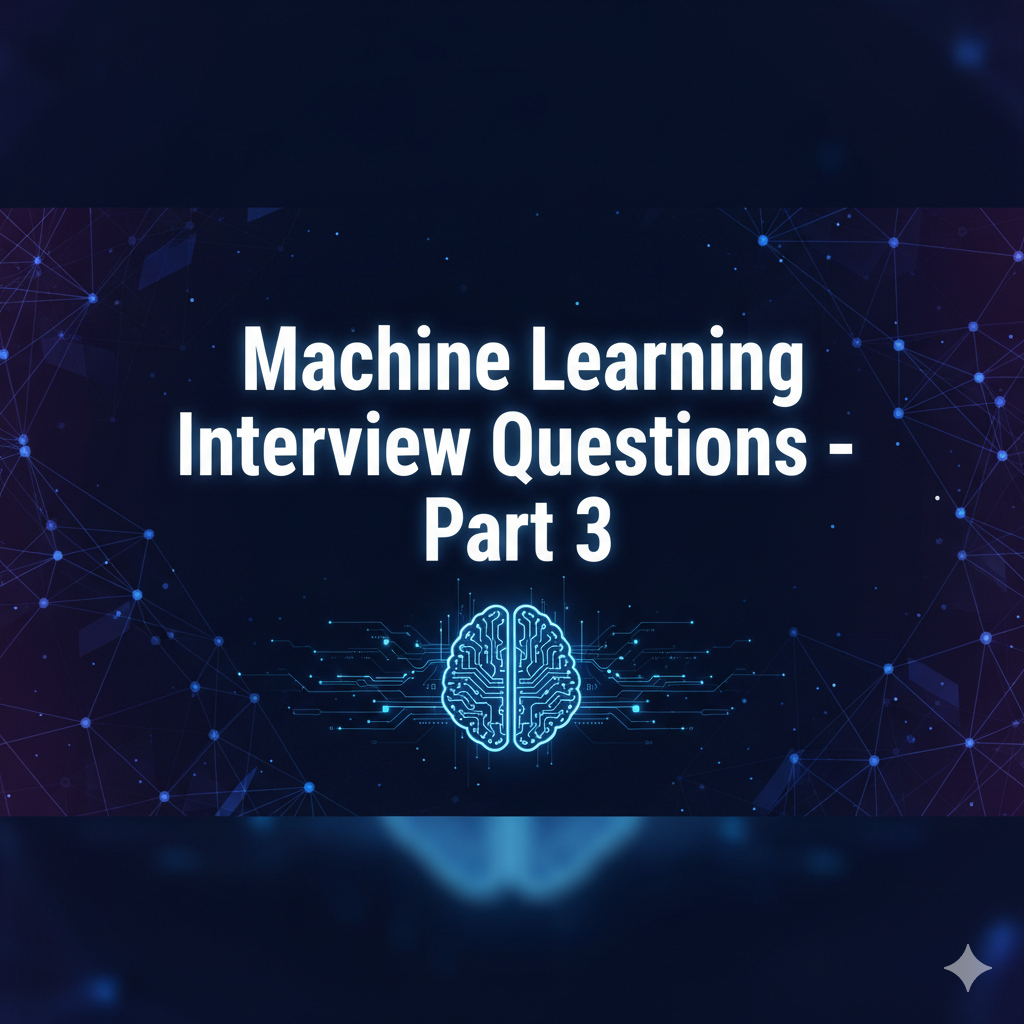Welcome to Part 3 of our Machine Learning Interview Questions Series, designed to elevate your knowledge from intermediate to advanced-level. This edition focuses on practical techniques, model ensembling, interpretability and real-world deployment, all of which are essential for demonstrating a well-rounded skill set in machine learning interviews.

Whether you’re preparing for a data scientist, ML engineer, or AI specialist role, mastering these advanced topics will help you explain not just what works but why it works in production.
21. What is Ensemble Learning in Machine Learning?
Ensemble learning combines predictions from multiple models to produce a more robust and accurate result than any single model.
Types of Ensemble Methods:
- Bagging (Bootstrap Aggregating): Trains models independently on different bootstrapped subsets.
Example: Random Forest - Boosting: Sequentially trains models, where each new model corrects the errors of the previous one.
Example: XGBoost, AdaBoost, LightGBM - Stacking: Combines multiple models using a meta-learner that learns how to best combine their predictions.
Why it works: Reduces variance, bias or both leading to better generalization.
22. What is the difference between Bagging and Boosting?
| Aspect | Bagging | Boosting |
|---|---|---|
| Goal | Reduce variance | Reduce bias (and variance) |
| Model Training | Parallel (independent) | Sequential (dependent) |
| Weighting | Equal | Higher weight to hard examples |
| Overfitting | Less prone | Can overfit if not regularized |
| Examples | Random Forest | XGBoost, AdaBoost, CatBoost |
23. What is ROC-AUC and why is it important?
ROC-AUC (Receiver Operating Characteristic – Area Under Curve) is a performance metric for binary classification.
- ROC Curve: Plots True Positive Rate (Recall) vs. False Positive Rate.
- AUC (Area Under Curve): Measures overall ability to discriminate between positive and negative classes.
Interpretation:
- AUC = 1 → Perfect classifier
- AUC = 0.5 → Random guessing
It’s especially useful when:
- Classes are imbalanced
- You want a threshold-independent metric
24. How do you handle imbalanced datasets?
Handling imbalanced datasets is critical in domains like fraud detection or medical diagnosis.
Techniques:
- Resampling Methods:
- Oversampling (e.g., SMOTE)
- Undersampling (random or cluster-based)
- Algorithmic Approaches:
- Use ensemble models like Balanced Random Forest
- Modify loss functions (e.g., class weights)
- Evaluation Metrics:
- Use Precision, Recall, F1-Score, AUC instead of Accuracy
25. What are Hyperparameters and how do you tune them?
Hyperparameters are configurations external to the model learned from data (e.g., learning rate, number of trees, regularization strength).
Tuning Techniques:
- Grid Search: Exhaustive search over a parameter grid
- Random Search: Randomly samples combinations (more efficient)
- Bayesian Optimization / Optuna / Hyperopt: Smart search using prior evaluation history
- Cross-validation: Always pair tuning with CV to avoid overfitting
26. What is Early Stopping in ML?
Early stopping is a regularization technique to prevent overfitting in iterative algorithms (e.g., gradient boosting, neural networks).
- Monitors validation loss or accuracy during training
- Stops training when performance stops improving
- Saves compute and improves generalization
Common in frameworks like XGBoost, LightGBM and TensorFlow/Keras.
27. What is Model Drift and how do you detect it?
Model drift occurs when the model’s performance degrades over time due to changes in data patterns (concept drift or data drift).
Detection Techniques:
- Monitor model performance metrics
- Track input feature distributions (e.g., KS test, PSI)
- Use drift detection tools (e.g., Evidently, Alibi Detect)
Solutions:
- Retrain models periodically
- Use online learning or adaptive models
- Implement feedback loops
28. How is a Machine Learning model deployed in production?
Key Deployment Approaches:
- Batch Inference: Run predictions in scheduled batches (ETL-style)
- Online Inference: Real-time prediction via APIs
- Streaming Inference: Event-driven predictions via Kafka, etc.
Deployment Tools:
- FastAPI / Flask: Serve models as REST APIs
- Docker + Kubernetes: Containerize and orchestrate for scalability
- Model Servers: MLflow, TensorFlow Serving, TorchServe
- Monitoring: Track latency, accuracy, drift
29. What is Model Interpretability and why is it important?
Model interpretability refers to understanding how a model makes decisions.
Why it’s crucial:
- Builds trust with stakeholders
- Required for regulated domains (e.g., healthcare, finance)
- Helps in debugging and bias detection
Tools:
- SHAP (SHapley Additive exPlanations)
- LIME (Local Interpretable Model-agnostic Explanations)
- Feature Importance from tree-based models
30. How do you choose the best model for a use case?
Model selection depends on:
- Data type and size
- Interpretability vs Accuracy tradeoff
- Latency and scalability needs
- Problem type (classification, regression, ranking, etc.)
General Strategy:
- Start with baseline models (Logistic Regression, Decision Tree)
- Compare performance using cross-validation
- Use ensemble or deep learning if needed
- Always factor in maintainability and deployment complexity
Conclusion
In this third part of our Machine Learning Interview Questions Series, we explored advanced ML topics that go beyond algorithms covering ensemble techniques, hyperparameter tuning, handling imbalanced datasets, model deployment and interpretability. These are the practical, system-level skills that interviewers expect from professionals working on real-world machine learning systems.
By building a strong understanding of these concepts, you’re better equipped to design robust, scalable, and production-ready ML solutions skills that are highly valued in technical interviews and day-to-day machine learning roles.
Stay tuned for Part 4 where we’ll focus on deployment architectures, ML system monitoring, cost optimization and open-source ML Ops tools.
Related Read
Machine Learning Interview Questions – Part 2

1 thought on “Machine Learning Interview Questions – Part 3”